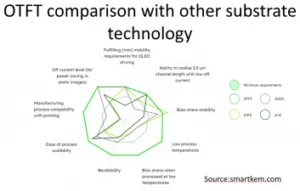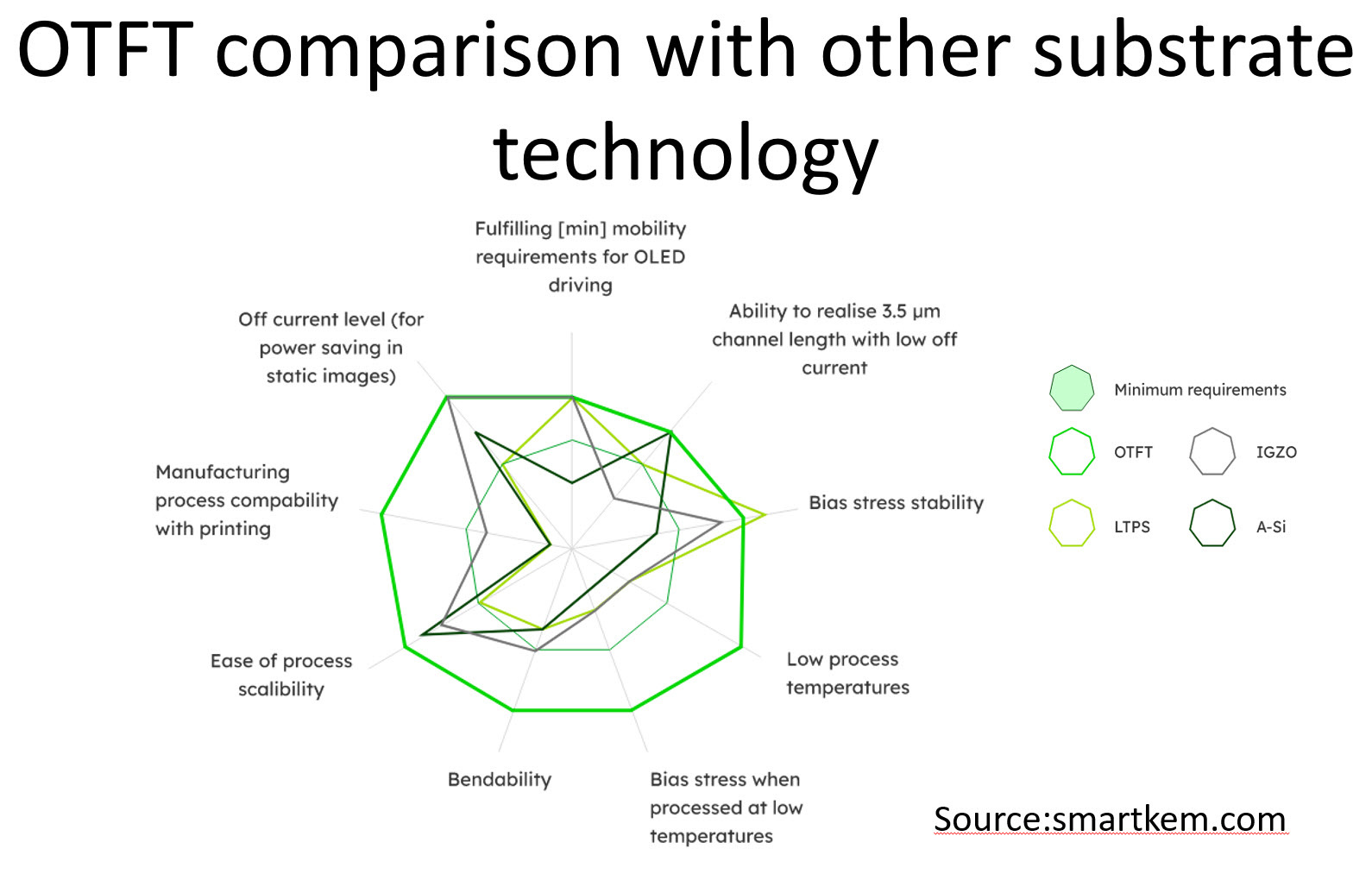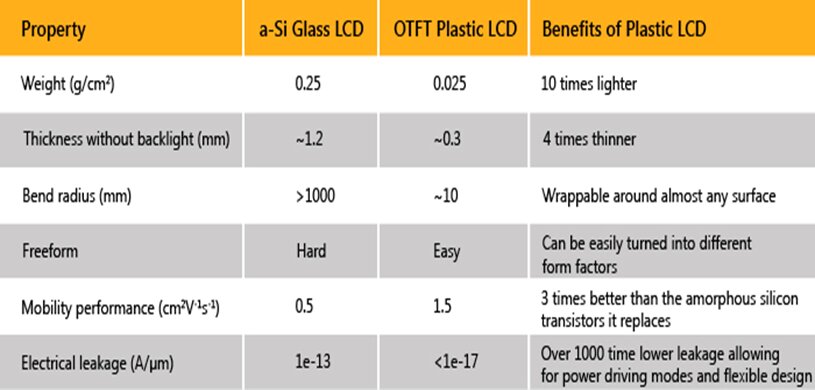SmartKem and Nanosys announced on Feb 2nd their joint development agreement to work together on a new generation of low-cost solution printed MicroLED and quantum dot materials for advanced display. Both companies believe a “fully solution-printed display” using SmartKem Organic TFT (OTFT) and Nanosys’s microLED and quantum dot nanoLED technologies should result in the creation of a new class of low power, robust, flexible, lightweight displays.

They are working on prototypes and hoping to show them this year. SmartKem has previously demonstrated miniLED backlight using OTFT and working with partners for OTFT-OLED. (You’re Going to Hear About Smartkem Again and Smartkem On the Up with RiTdisplay JDA ) FlexEnable has shown example of OTFT-based flexible OLED displays. The company is working on glass-free flexible OTFT LCD (OLCD) and expects first production ramp up in 2H 2022. (Novares Integrates FlexEnable’s Conformable OLCDs into its New Demo Car: Nova Car #2 and Cambridge-Based Electronics Company Raises Up to $25m Series B Fund to Accelerate Production of Flexible Displays and Active Optics)
OTFT can offer truly flexible backplane technology (with a small bend radius), fewer masks (than a-Si or LTPS), low process temperatures, low current usage, wide substrate compatibility and low cost manufacturing processes. OTFT displays are not yet in mass production but if the potential for OTFT can be realized with joint technology developments, it can open up new opportunities for the display market.
Organic TFT: an alternative to a-Si, LTPS or Oxide backplane
Organic thin-film transistors (OTFT) technology platform allows electronics to be manufactured on flexible films up to sub-mm (0.5mm) bend radius. It can be integrated with frontplanes such as LCD, EPD (e-paper), OLED, MiniLED, MicroLCD and NanoLED. It has better mobility than amorphous silicon but lower mobility than oxide or LTPS. According to the OTFT suppliers, the mobility is enough for most application segments. It enables manufacturing like other substrates but can use a lower cost flexible substrate (TAC film/plastic) compared to LTPS or Oxide (Polyimide). Its processing temperature (<100 degrees) is low compared to a-Si, Oxide, or LTPS (300 to 350 degree). It has long operating lifetimes and very high uniformity for large area manufacturing. Its manufacturing process cost is low as display makers can repurpose existing LCD lines with minimal investment. It can be scaled up to any generation fab and has the potential to create truly flexible and cost effective display solutions.
Quantum Dot: Enabling LCD, OLED, MicroLED and NanoLED
Quantum Dot technology enhances LCD, OLED and MicroLED displays and is progressing towards self-emissive NanoLED (ELQD). The technology has evolved during the last few years to improve or eliminate many challenges, resulting in broader adoption of QDs. Nanosys’s new aerobically stable xQDEF is lowering costs and helping to increase manufacturability. QD enhancement film (QDEF) enabled LCDs to get to market.
QDOLED displays from Samsung Display has entered the market in 2022 with product demos at CES. QDOLED combines the best of OLED and QD technology: it provides very high contrast (due to the OLED sub-pixel), perfect black, wider viewing angles with better color gamut and higher brightness. However there are still many challenges. Blue emitting materials still have efficiency and lifetime issues. Multiple layers of blue OLED can be used to reduce the problem.
OTFT enabling: QD-MicroLED
The mass transfer process that requires bonding RGB (Red Green Blue) MicroLED to the display backplane accurately and efficiently is very challenging. Using single-color (blue) MicroLED chips and color converting them with QD layers can help in the manufacturing process. There have been many announcements and prototypes but no mass production yet. Nanosys has acquired “gl?” a company specialized in MicroLED technologies, including epitaxy as well as device and transfer technology.
SmartKem, is the developer of materials and processes used to make OTFTs for the manufacture of flexible electronics. The truFlex semiconductor technology from the firm deposits organic ink on a substrate at a temperature as low as 80°C, enabling manufacturers to use a range of low-cost flexible plastic substrates with existing industry standard equipment and infrastructure. The joint development agreement with Nanosys announced that the initial validation work on the equipment, process and materials readiness has already occurred.
There is already mass production partnership with display suppliers. The joint development agreement contemplates that through the application of its unique truFlex technology, SmartKem will provide OTFT backplanes to enable the manufacture of microLED displays using Nanosys’ microLED and ELQD technologies. truFlex materials have been developed for standard process equipment sets and have the benefit of both lower material and equipment costs than traditional alternatives such as LTPS. According to Sri Peruvemba, CMO at SmartKem, “Now that two companies SmartKem and Nanosys are working together, their synergies may revolutionize the display industry”. They are already working with MicroLED companies’ partners, and hoping to show prototypes this year. (for more about this deal see last week’s Display Daily Smartkem & Nanosys Expand on Joint Development)
OTFT enabling: QD NanoLED
Nanosys has been actively developing electroluminescent quantum dot (EL-QD) technology which it calls “NanoLED”. It uses solution-printed QDs as the emitter material to make AM emissive displays. Printable, low cost QD materials with superior performance have the potential to directly compete with OLED displays even in the flexible segment. SmartKem OTFT is a printed technology. The firm has built products on its pilot line and is transferring technology to display suppliers.
The most important factor is the potential for lower cost. Nanosys has the experience of taking QD technology from lab to fab in the display industry. This unique combination of two technologies OTFT and QD has the potential to allow lower cost products. Russell Kempt, Nanosys VP of marketing said “Development of OTFT backplane for MicroLED and NanoLED can be potentially a game changer for the display industry”.
OTFT backplane: For MiniLED
OTFT can be used for miniLED backlight with full array local dimming (FALD). SmartKem has demonstrated miniLED backlight for HDR LCD with over 100,000 cd/m² of brightness. FALD is a process of locally controlling LED light levels in a segmented backlight unit to enhance contrast in images while decreasing the “halo” effect around bright areas on black backgrounds. It requires thousands of miniLEDs to deliver the intended picture quality and this increases the manufacturing cost of the backlight unit. According to SmartKem: by the use of an OTFT backplane approach, miniLED runs much more efficiently and delivers improved quality at a much lower cost.
OTFT substrate: For OLED
As OTFT is already a fundamentally flexible substrate; when combined with flexible frontplanes like OLED displays displays can be truly foldable. OTFT uses low processing temperature that allows it to be manufactured on a lower cost plastic substrates bringing in cost and manufacturing benefits to OLED. FlexEnable has demonstrated flexible OLEDs with OTFT backplanes with Novaled (OLED material supplier). In 2021, SmartKem announced a joint development agreement with PMOLED maker RiT display for the production of OTFT-based AMOLED display. This could enable RiT display to use its PMOLED production line to produce AMOLED display without a large investment.
OTFT enabling: Flexible OLCD
FlexEnable arranged to be able to raise $11 millon -$25 million in February this year to take flexible displays and active optics to mass production. (Cambridge-Based Electronics Company Raises Up to $25m Series B Fund to Accelerate Production of Flexible Displays and Active Optics) It is expected to finance the company for its mass production ramp up of flexible displays and LC optical modules at Asian display manufacturing partners. Coretronic, a major LCD backlight module manufacturer has made strategic investment in the company. FlexEnable has a complete set of manufacturing process and FlexiOM organic semiconductor materials.
Together it enables manufacturing of glass-free flexible OLCD and LC Optics in existing fabs allowing ultrathin, light, flexible and even 3D confirmable products. The company already has four active technology transfer programs underway with several leading display manufacturers in Asia with first volume production ramp starting in the second half of 2022. It has the potential to go into multiple mainstream applications and display segments where flexible displays are absent today.
There are many different applications: flexible cylindrical for smart speakers, curved displays for automotive, thin light bezel less notebooks and tablets, or for dual cell TVs with true pixel-level dimming and higher transmission than glass-based dual cells. OTFT LCD cost will be very similar to glass a-Si LCD as many components are the same such as polarizers and backlights.
According to Paul Cain, Strategy Director for FlexEnable
“OLCD is by far the lowest cost flexible display, because of the simple low temperature process and substrate handling, and re-use of many of the cost-optimized existing LC supply chain components”.
He also added that OLCD is better in terms of sustainability because of low manufacturing temp with no CVD steps and the production process uses 25% less energy than a-Si fabs. Also they are designed to use existing a-Si LCD fabs and can achieve the same PPI and resolution. OTFT LC cells can be combined with many different types of backlights (e.g. miniLED, edge-lit) which can be flexible. Setting up the process, technology transfer, and display suppliers deciding to adopt the technology in their fabs takes time.
Implications: OTFT & QD will open new opportunities
The new joint technology development agreements and higher investments can open up new opportunities for the display industry.
- Availability of low cost flexible display due to low temp processes, reuse of cost optimized fabs and using the existing supply chain
- Flexible organic LCD products that don’t exist today
- Potential for lower cost OLED and MiniLED backlights
- Commercialization of low cost QD MicroLED displays
- Fully solution-printed emissive display ELQDs without multibillion capital investment or massive fabs
Technology innovations and supply chain collaborations are really critical for the next generation of OTFT based displays to transform them from prototypes to successful commercial products with volume production that can compete effectively with OLED and LCD in future. (SD)
Sweta Dash, President, Dash-Insights
Sweta Dash is the founding president of Dash-Insights, a market research and consulting company specializing in the display industry. For more information, contact [email protected] or visit www.dash-insights.com



